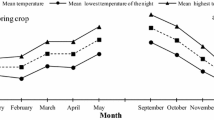Summary
The components of the alcohol-soluble nitrogen of potato tubers (cv. British, Queen) infected by leaf roll virus were examined in an attempt to correlate nitrogen translocation and the reduction in size and yield of the tubers. Infection was found to increase all the soluble nitrogen fractions except ammonia and asparagine. It is concluded that infection interferes in some way with the normal process of tuber expansion but that shortage of translocates is not responsible for the reduction in the infected tubers.
Zusammenfassung
Der alkohollösliche α-Amin-, Amid- und Ammoniakstickstoffgehalt von mit Blattrollivirus infizierten Kartoffelknollen (Sorte British Queen) wurde im Hinblick darauf untersucht, ob der Einfluss der Infektion auf die beweglichen Stickstoffverbindungen für die Reduktion von Grösse und Ertrag von mit der Krankheit befallenen Knollen verantwortlich war. Es wurde festgestellt, dass eine Infektion, im Vergleich mit gesunden Kontrollen, zu höheren alkohollöslichen α-Amin- und Glutamin-Stickstoffraktionen führt (Abb. 1 und 2). Ein erhöhter Ammoniakgehalt wurde nur in Knollen von alternden Pflanzen gefunden (Abb. 2). Der Asparaginamid-Stickstoffgehalt war, wenn auch nicht gesichert, während der gesamten Wachstumsperiode kliner (Abb. 2). Daraus wird geschlossen, dass eine Knappheit an beweglichen Stickstoffverbindungen nicht für die Verminderung von Grösse und Ertrag von erkrankten Knollen verantwortlich ist und dass die Infektion mit Blattrollvirus in irgendeiner Weise in den normalen physiologischen Vorgang des Knollenwachstums eingreift.
Résumé
Les constituants azotés solubles dans l'alcool provenant de tubercules infectés par le virus de l'enroulement (α-amine, amide et ammoniac) ont été examinés dans le but de déterminer si l'effet de l'infection sur la migration de l'azote était responsable de la réduction de taille et de rendement des tubercules malades. Il a été montré que, par rapport au témoin sain. l'infection augmente les fractions azotées solubles dans l'alcool d'α-amine (Fig. 1) et de glutamine (Fig. 2). La concentration en ammoniac s'élève seulement dans les tubercules prélevés sur des plantes sénescentes (Fig. 2).
La teneur en asparagine diminue, bien que l'effect ne soit pas significatif, tout au long de la période de végétation.
On en conclut que l'absence de migration n'est pas responsable de la réduction de taille et de rendement des tubercules malades et que l'infection provoquée par le virus de l'enroulement interfère en quelque sorte avec le processus physiologique normal du développement des tubercules.
Similar content being viewed by others
References
Barker, A. V. & R. J. Volk, 1964. Determination of ammonium, amide, amino and nitrate nitrogen in plant extracts by a modified Kjeldahl method.Analyt. Chem. 36:439–441.
Bligh, E. G. & W. J. Dyer, 1959: A rapid method for total lipid extraction and purification.Can. J. Biochem. Physiol. 37:911.
Harmey, M. A. & A. Cassells, 1969. Effect of leaf roll, virus infection on the nucleotieds of potato starch grains.Sci. Proc., Royal Dublin Soc., 3:203–207.
Harmey M. A., M. P. Crowley & P. E. M. Clinch, 1968. An investigation of carbohydrate accumulation in the leaves of leaf roll infected potato plants.Sci. Proc., Royal Dublin Soc 3:87–105.
Loughnane, J. B., 1941. The susceptibility to leaf roll of certain potato varieties and its effect on their yield.J. Dep. Agric., Rep. Irel. 38:48–67.
McDonald, M. S. 1969. Ph. D. Thesis, National University, Ireland.
McDonald, M. S., 1974. Isolation of pipecolic acid from the tubers of leaf roll virus infected potato plants.Z. Pfl. Physiol. 73:371–375.
McDonald, M. S., M. P. Crowley & P. E. M. Clinch, 1971. Micro-Kjeldahl apparatus and digestion procedure.Lab. Practice 20:239–240.
Palfi, G., 1968. Relationship between the pipecolic acid content of the leaves and the physiological condition of rice plant.Il Riso 1:13–22.
Pucher, G. W., M. B. Vickery & C. S. Leavenworth, 1935. Determination of ammonia and amide nitrogen in plant tissue.Ind. Engrg. Chem. (anal. ed.) 1:152.
Sehgal, O. P. & D. M. Boone, 1964. Amino acid and amide content of healthy and multiplier diseaseaffected strawberry plants.Phytopathology 54:775–778.
Vickery, M. B., G. W. Pucher, M. E. Clarke, A. C. Chibnall & R. G. Westall, 1953. The determination of glutamine in the presence of asparagine.Biochem. J. 29:2710.
Sims, A. P., B. F. Folkes & A. M. Bussey, 1968. Recent aspects of nitrogen metabolism in plants. Academic Press, 91–114.
Yemm, E. W. & E. C. Cocking, 1955. The determination of amino acids with ninhydrin.Analyst 80:209–213.
Author information
Authors and Affiliations
Rights and permissions
About this article
Cite this article
McDonald, M.S. Effects of leaf roll virus infection on the development of tubers in the potato plant. Potato Res 19, 349–355 (1976). https://doi.org/10.1007/BF02359853
Accepted:
Issue Date:
DOI: https://doi.org/10.1007/BF02359853




